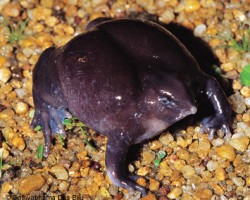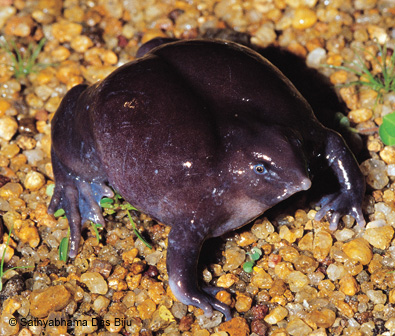Scientists Study Rare Species With Unique Behavior
UNUSUAL: Have you ever come across a weird-looking purple colored frog with a plump body and characteristic pointed snout? Chances are you have never even heard about their existence until now, because these fascinating members of the animal kingdom were only discovered as recently as in 2003. Now scientists are trying to find more about this unusual creature and why it sings.
An endangered species, the elusive and unique purple frog is native to the Western Ghats of India. In fact, the Nasikabatrachus sahyadrensis is the only know species in the family Nasikabatrachidae. Some of this frog’s unusual looks stem from the amphibian’s adaptations for its peculiar burrowing lifestyle, where it uses its short, stout limbs and pointed snout to dig as far as 12 feet (3.7 meters) below the surface. Unlike most frogs, this particular frog remains underground most of the year, surfacing only for about two weeks during the monsoon season for the sole purpose of mating.
Advertisement Calls from Underground
What makes this pig-nosed frog really stand out is the way in which the males call out from just below the surface – under a thin layer of loose dirt and humus – usually after episodes of rain.
The male purple frogs sit near the openings of small tunnels partially filled with loose dirt, and make unique advertisement calls to attract female purple frogs and also to communicate with other male frogs.
Such below-the-surface vocalizations are relatively uncommon in frogs. Moreover, these frogs also make sure that the top layer of the soil is thick enough to fully conceal their body, while still being thin enough to allow vocalizations to be audible and to also reveal gross movements associated with calling, such as inflation of vocal sac and contraction of the trunk musculature.
These vocalizations are all the more intriguing considering these purple frogs lack an ear drum (tympanum) and sound is ‘heard’ through the body walls and lungs!
Most frogs have an ear drum that transmits sound energy to the inner ear from the outside via a single middle ear ossicle (the stapes, or columella). However, in species like the purple frog and members of the genera Bombina (Bombinatoridae), Eleutherodactylus (Eleutherodactylidae), and Atelopus and Mertensophryne (Bufonidae), the frogs’ body walls and lungs serve the function of the tympanum, transmitting sound energy to the inner ear.
Listen to the frog’s song here,
Sound Search
Scientists from the University of Minnesota, USA, and the University of Delhi, India, recorded the advertisement calls of male purple frogs in April 2012 in Methotti, Kulamaav, a tribal settlement on the outskirts of Idukki Wildlife Sanctuary in Kerala. The results of the extensive study of the purple frog’s bioacoustics were published on February 7, 2014 in the journal PLOS ONE.
The researchers first pinpointed the underground location of these frogs since the vocalizations disturb the thin layer of soil above the concealed frogs due to the contraction of muscles to inflate and deflate the vocal sacs. However, it wasn’t an easy task trying to catch these frogs since even a slight disturbance in the vicinity of the frogs’ calling sites caused them to cease calling and immediately retreat into the tunnels deep below the surface.
Experts believe that the purple frogs are a relic of an early evolutionary divergence and thus the study of their sounds will make them know much about the evolution of amphibians as well as their vocal communication system.
What is ‘bioacoustics’?
Bioacoustics is the study of sound production, dispersion, and reception in animals, including humans. Given the significance of acoustic signaling in the breeding behavior of most anuran amphibians i.e. frogs and toads, this field of study plays a vital role in understanding and deciphering several issues related to the study of these creatures. Moreover, bioacoustics can also be used by conservationists as a noninvasive tool for population census and monitoring.
More About the Purple Frog
Common Name – Purple frog, Pignose Frog
Scientific Name – Nasikabatrachus sahyadrensis
IUCN Red List Status – Endangered
Fast Facts
- First discovered in October 2003 in the Idukki district of Kerala by S.D. Biju from the Tropical Botanic Garden and Research Institute in Palode, India and Franky Bossuyt from the Vrije Universiteit Brussel (Free University of Brussels).
- Described as one of the rarest species in the world and ‘once in a century find’ by experts.
- Endemic to Western Ghats of India, the frog remains underground all round the year except two-three weeks in the mating season.
- The purple frog seeks out its termite prey using its touch-sensitive snout, and sucks the termites up with its fluted tongue.
- Only 135 individuals of this species are known, of which only 3 are females.
- The major threat to it is habitat loss due to human encroachment.
More related Stories,
Western Ghats Become a world heritage Site
Can Saving a Tiger Help Save a Rare Frog too?
Image courtesy Edgeofexistence.org






